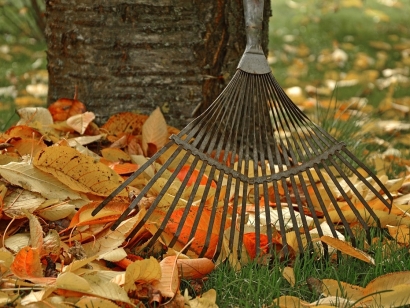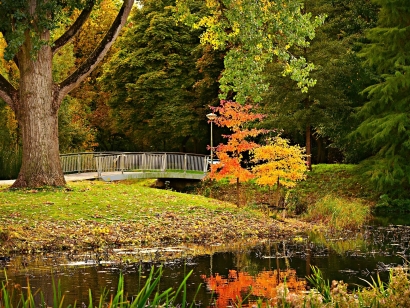
Before the weather turns cold, you want to prepare your lawn for winter. With natural turf, winterizing involves several steps to pave your way for lush, healthy spring grass. Artificial grass means an end to 99% of fall lawn preparations, but there are some things you need to do for your yard to look fresh and clean before it's too chilly to spend time outdoors.

Winterizing a lawn is more critical if you cool-season turf (Fescue, Kentucky bluegrass, or perennial ryegrass.) These types of grass grow more in fall; it's recommended to apply winterizer fertilizer in October or November.
Warm-season grass (Bermuda, St. Augustine, centipede, zoysia) goes dormant in close-to-freezing temperatures. In Northern regions, colder temperatures typically happen in the fall; the last fertilization must be done before September 1.
The reason why the fall fertilizing is so effective is because plants respond to key things like shortened daylight and cooler temperatures. As air temperatures fall, plants shift excess nutrients from leaves to roots. Those food reserves fuel the spring growth. By winterizing turf in fall, you give additional nutrients to the roots for winter storage. It helps your lawn get green and lush quickly in spring and gives it enough strength to fight weeds.
Artificial grass doesn't need fertilization; it always stays perfect no matter the temperature or daylight periods. All you may do is cleaning up leaves from the turf surface.
Mosquito season tapers off into fall. Mosquitoes do not go away until the first freeze, and the temperatures stay consistently below 50 degrees. Even though you live in a colder state, take care of their breeding sites on your property. Did you know that female mosquito can lay up to 400 eggs? That's a reason why its population increases so quickly. Walk around your property and make sure there are no cans, containers, clogged rain gutters, potholes, tree holes, old tires, or flower pots with standing water.
If you have a water fountain, a birdbath, or any other water standing feature in your yard, you may want to change the water before the last mosquitoes are gone to kill mosquito larvae. For ponds, use the mosquito control rings to kill the mosquito larvae. Don't forget to take care of algae, because mosquitoes feed on it and on small organisms that live in water.
Yellow and red leaves look pretty, but raking it off goes back to the lawn health. Natural grass has to "breathe." If leaves are matted down into the wet layers, next spring, you will find bald spots on your lawn because these layers of leaves block water, nutrients, and airflow from getting to the grass root system.

You can use your lawnmower to mulch leaves; it's a great way to prepare your yard for the winter. Mulching mixes nitrogen-rich grass clipping with carbon-rich shredded leaves and dramatically reduces the volume. The mix decomposes quickly and provides extra nutrients for grassroots. Make sure the grass and leaves are dry. If you have lots of trees dumping leaves, mow over it about once a week.
Some people like to use a hand-held leaf blower and vacuum. It's loud but does an excellent job of shredding leaves and cleaning driveways and sidewalks.
Raking off leaves with a lawn rake is not glamorous, but efficient. Choose the wide rake to cut down the raking time.
Typically, it takes 3-4 days before the layer of leaves starts to smother your lawn, especially when leaves are wet. If you have a large yard with lots of deciduous trees, start cleaning up earlier until it becomes a big lawn-cleanup project.
With a synthetic lawn, you don't need to worry about roots, nutrients, and timing. While you can't let leaves stay on a natural lawn for more than four days, you can clean up the synthetic lawn at your own convenience; leaves or any other types of organic/inorganic residue don't damage artificial turf.
You can use leaf blower and vacuum, bag shredded leaves, and use it in various ways.
Raking leaves off the synthetic lawn must be done carefully. You don't want to break the integrity of blades with a metal garden rake. Use a specialized artificial turf rake (groomer) with nylon tines to carefully life and pull leaves from a surface. This will increase the lifespan of your investment.
If you have a power broom, use it; a power broom sweeps debris quickly and improves the look of the synthetic lawn.
The worst thing you can do is to push your leaves to the curb for pickup. Leaves are high in nutrients and work perfectly as an organic matter (and free fertilizer.)
Why don't just send leaves to the landfills? According to EPA data, yard trimming created about 13% of all waste generated. The worst thing to do is to bag leaves and throw them in a garbage can. Leaves can break down with other organic waste and create methane, a greenhouse gas that contributes to climate change.
If you have lots of leaves, shred them, stash in the plastic trash bags and use it next spring as mulch. It looks fabulous and does wonder to the soil. Whole leaves can be added to the composted pile with high nitrogen food scraps and other organic waste; it will keep the mixture soggy and compacted. Don't use whole leaves for a mulch; they form a mat that water can't penetrate.
You can use shredded leaves to insulate tender plants and cover cold-hardy vegetables like carrots, leeks, kale, and beets to harvest them all winter.
You can shred leaves, pile them up, and let it sit for a year or so. As soon as the pile begins decomposing, you can use it as a soil amendment mixing it right into your garden.
You can also make a "leaf mold" out of shredded or whole leaves; it's high in magnesium and calcium; retains up to five-time its weight in water rivaling peat moss.
Tip: if you are adding shredded leaves right into the soil, use slow-release nitrogen fertilizers. It will help leaves decompose and ensure that microbes in the soil don't utilize all of the available nitrogen.